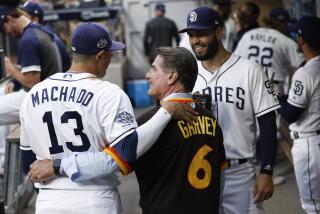Gene Savoy, 80; swashbuckling explorer found lost cities in Peru
- Share via
Gene Savoy, the swashbuckling adventurer who discovered the legendary Inca city of Vilcabamba, hacked through the mountain jungles of Peru to identify 40 other cities and sailed the oceans in re-creations of primitive vessels to prove his theories about the origins of indigenous South Americans, died of natural causes Sept. 4 at his home in Reno.
He was 80 and had for several years suffered from heart problems that prevented him from returning to the Peruvian mountains.
Lean and lanky with a bandido mustache and a Stetson hat, Savoy embodied the image of the bold explorer. People magazine called him “the real Indiana Jones,” and he did his best to uphold the image, calling frequent news conferences to announce his latest discoveries.
But archaeologists alleged that many of his “discoveries” had already been mapped and reported by Peruvian archaeologists or were known to locals, and that his publicizing their locations without scientific follow-up opened them to looting and environmental degradation.
Savoy dismissed his critics as “fuddy-duddy academics. . . . Exploring is the key. The scientist tells you what you have found, but you have to find it in the first place.”
A small-town journalist in his native Oregon, Savoy hopped a plane to Peru in 1957 after both his newspaper and his first marriage failed. Writing stories for the English-language Peruvian Times, he began studying ancient texts looking for the location of El Dorado, the fabled city of gold.
Instead, he deduced the location of Vilcabamba, which may have been the last refuge of the Incas as they fled from Spanish conquistadors. By 1965, he had convinced Peruvian authorities and private donors about his findings and set off into the jungle with 100 men and hundreds of horses and mules. After 14 days, they found the site, which has become a major tourist attraction.
Over the next 40 years, Savoy discovered a host of other sites, including Gran Pajaten, Gran Vilaya and Gran Saposoa. Along the way, he was bitten by snakes, lost in the jungle, chased by guerrillas and nearly lynched by irate campesinos. “I hate the danged jungle,” he said. But, he added, “I would rather die out there than not explore.”
When his heart condition prevented him from returning to Peru, he said, “I feel half alive.”
Savoy also took to the seas. In 1969, he built a totora-reed raft that he sailed 2,000 miles from Peru to Central America in an effort to prove that the Aztecs and Incas were in contact.
From 1977 to 1982, he was captain of the research schooner Feathered Serpent II, examining prevailing winds and sea currents in the search for possible trade routes between Asia and the Americas.
In 1997 and 1998, Savoy led a small group that sailed a double-hulled catamaran of ancient design from Callao, Peru, to Hilo, Hawaii, in a 42-day voyage.
Douglas Eugene Savoy was born May 11, 1927, in Bellingham, Wash. He served as a Navy gunner during World War II before becoming a journalist at the State Review, the voice of the logging industry in Oregon. He later became editor of the Lombard Booster, a weekly business newspaper in North Portland.
An ordained minister since 1962, Savoy established and became head bishop of the International Community of Christ, Church of the Second Advent, in 1971. He created a new theology called Cosolargy, which taught that the second coming of Christ had already become a living reality through a miraculous celestial event.
Savoy wrote dozens of books. Some, such as “Antisuyo: The Search for the Lost Cities of the Amazon” and “On the Trail of the Feathered Serpent,” recounted his explorations. The majority, however, explored and developed his new theology.
When he moved to Reno in 1971, Savoy established the Andean Explorers Foundation & Ocean Sailing Club, which sponsored many of his explorations.
He received many awards from the Peruvian government for bringing attention to a region that was thought to be archaeologically barren and from the country’s Ministry of Tourism, as well as from Peruvian tourist associations.
Savoy is survived by two sons, Gene Jr. and Christopher Sean of Reno, who worked with him on his expeditions; a daughter, Sylvia Jamila Savoy, also of Reno; three brothers, Bill Dailey of Reno, Jack Dailey of Medford, Ore., and Douglas Leon Dailey of Talent, Ore.; and three granddaughters.
--
More to Read
Sign up for Essential California
The most important California stories and recommendations in your inbox every morning.
You may occasionally receive promotional content from the Los Angeles Times.










